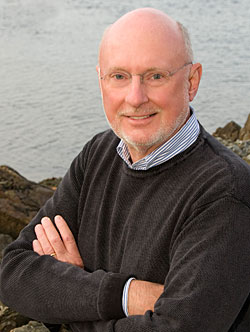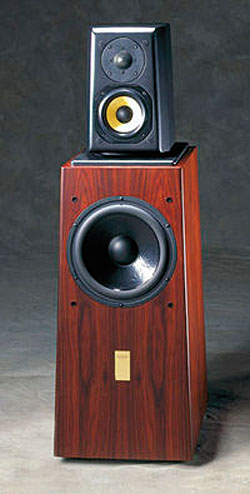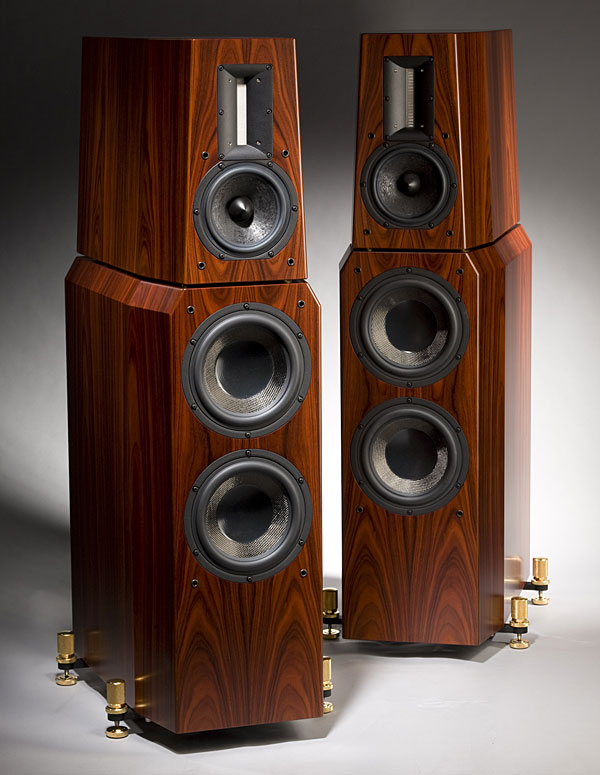| Columns Retired Columns & Blogs |
Would have been nice to learn something tangible about the actual design and performance of his speakers.
 Aerial Acoustics, the speaker firm that Michael Kelly conceived a quarter-century ago with David Marshall, is headquartered north of Boston, not far from the Merrimack River Valley region that once produced textiles and shoes by the trainload. Kelly, though, is quick to equate Aerial with far more distant firms. His industrial models are in Germany, where he lived for a while when his father, a US Army officer, was based there, and where he later spent time as a vice-president of a/d/s/, which had been founded by a German-born and -educated scientist, Godehard Günther, who died last October. They're small-to-midsize specialty firms that together constitute a category called Mittelstanden, and they're as accomplished as they are narrowly focused. They're artisan enterprises, and it's only natural that someone as dedicated as Kelly is to building state-of-the-art loudspeakers would embrace them as examples.
Aerial Acoustics, the speaker firm that Michael Kelly conceived a quarter-century ago with David Marshall, is headquartered north of Boston, not far from the Merrimack River Valley region that once produced textiles and shoes by the trainload. Kelly, though, is quick to equate Aerial with far more distant firms. His industrial models are in Germany, where he lived for a while when his father, a US Army officer, was based there, and where he later spent time as a vice-president of a/d/s/, which had been founded by a German-born and -educated scientist, Godehard Günther, who died last October. They're small-to-midsize specialty firms that together constitute a category called Mittelstanden, and they're as accomplished as they are narrowly focused. They're artisan enterprises, and it's only natural that someone as dedicated as Kelly is to building state-of-the-art loudspeakers would embrace them as examples.
David Lander: You've said that a high school English teacher tapped you to direct the senior-class play when you were still a junior, which reveals your affinity for the arts. Yet you claim that, during your boyhood piano studies, you just kept trying to play the instrument faster.
Michael Kelly: I think I confused the piano with the typewriter.
Lander: Were you in a similar rush to get the doctorate you were working toward in North Carolina, back when your career goal was research in plasma physics?
Kelly: I was just working like crazy. I burned out.
Lander: For a time, you sold audio components in North Carolina, at a store called Soundhaus, in Chapel Hill.
Kelly: I ended up being their best salesman. It floored me. I had no idea I'd be a good salesman.
Lander: It was at Soundhaus that you met a/d/s/ founder Godehard Günther, who hired you to head up speaker-manufacturing efforts and, ultimately, move into product design at his company, where you spent 12 years. When you were about to leave, Godehard offered you an opportunity to go back to graduate school. You excelled at physics—years earlier, you'd been awarded a National Science Foundation fellowship to grad school in that discipline—but this time around, you opted for a business-management program.
Kelly: Godehard's gift to me, when I left a/d/s/, was to pay my tuition and living expenses for an MBA at MIT's Sloan School. What a gift! It was a complete surprise to me, and it was incredibly magnanimous. I thought it was a good idea, because I wanted to go from building speakers to building a company that could build speakers. At the end of the day, it was mostly academic, because it didn't apply to the kind of business I wanted to run—a small, tightly controlled business based on the small-European-company model. That was firmly fixed in my mind before MIT, and still is. By the time I left a/d/s/, I was in charge of all design, manufacturing, and most operations. We had 145 people, and most of them reported to me, but I'm really a hands-on person, and that requires operating on a smaller scale. At Aerial, I generally spend about half my time on product design and development, which is still what I love best, and the rest on management and operations. I did need the additional tools that would allow me to build a company, not just products, which I think is what Godehard wanted to give to me through MIT. I certainly thank him for that.
Lander: You and I first met when I did some writing for a/d/s/, and your attention to detail was obvious. I remember how particular you were about choosing the large wreath you installed in the office at Christmastime. That facet of your personality is also very apparent in Stereophile's 2004 review of your 20T speaker. You're quoted there as saying that, before deciding on the 20T's tweeter, you "listened to everything, every ribbon I could get my hands on." And you noted that development of the midrange driver took more than two-and-a-half years and 28 prototypes. I'm puzzled, though, by one aspect of Aerial's debut speaker, the 10T (footnote 1). The top cabinet's look is a bit crude, which seems odd, since you aren't one to neglect the appearance of things.
 Kelly: It's true; the 10T is not particularly good looking.
Kelly: It's true; the 10T is not particularly good looking.
Lander: It certainly doesn't mirror the esteem you've expressed for the German industrial designer Dieter Rams, some of whose hi-fi components were sold here under the a/d/s/ name. Rams, of course, is renowned for numerous Braun products that are now classics, from calculators, clocks, and coffee grinders to radios and watches.
Kelly: With the 10T, we were trying for absolute performance and were driven by function. Because of low-volume production and higher cost per unit, if we had also tried to have great looks, it would have been too expensive. Why would anyone, when we were just starting out, have bought an Aerial if it had been the same price as a B&W? So we went for performance at a reasonable price.
Lander: The visual elegance of your current towers, the 7T and 6T, are much more in character. Can we expect future Aerial speakers to display that level of taste?
Kelly: Absolutely.
Lander: Which Aerial model has been your best seller?
Kelly: The 10T. I think the 7T will, in the long run, be our best-selling product ever. It hasn't caught up with the 10T yet; it hasn't had enough time.
Lander: You and your partner, David Marshall, worked on the 10T for two years before introducing it.
Kelly: We started designing it in 1989, and incorporated the company and started selling it in the same month in '91. I got married that year, too. We grew to a peak of about 10 people, and eventually ended up in Wilmington, Massachusetts, in around 2000. We took over, from Bausch & Lomb, their contact-lens plant—15,000 square feet in a contemporary building in Wilmington Technology Park. We have a clean, bright, well-equipped production facility, where every Aerial speaker is assembled, tested, and packed by trusted, long-term employees. There are open, contemporary offices and ample warehousing. We added R&D facilities, and a beautiful sound room.
Lander: Do you still view the 10T as one of your major achievements?
Kelly: Yes. I think the Novalith cast head is pretty important.
Lander: That's the top enclosure, which houses the 10T's treble and midrange units. Tell us about its development.
Kelly: We started out building the head from wood, and we kept making it thicker and thicker, and every time we'd make it a little thicker and make it deader, we could hear an improvement in clarity and definition and musicality. It was getting bigger and bigger, and finally we said, this is ridiculous—you want it to be small acoustically, but you want it to behave like it's massively inert. You can use cast stone, but cast stone will ring, so we developed a material, which is a modified stone—not a plastic, but a modified calcium carbonate—with some ingredients that I think I need to keep secret. It's very heavy. We decided to go all the way and cast it ourselves, 100%. We finished it all in-house, which is very, very hard to do.

Lander: You don't use Novalith anymore.
Kelly: No [laughs], but we might. I can't say any more than that. The 20T (footnote 2) is a very different thing, because we rely on very, very good cabinetmakers. We basically use dual walls: an inner cabinet and an outer cabinet. The outer cabinet is trying to compress the inner cabinet, and the inner cabinet is trying to break out of the outer cabinet, so there's tension between the two. And in between the two of them is a soft, energy-absorbing material, like asphalt.
Footnote 2: Reviewed first by Michael Fremer in April 2004 and then by John Atkinson in November 2009.

Would have been nice to learn something tangible about the actual design and performance of his speakers.

Making cabinets out of inherently 'dead' material is always good. And it need not be crazy expensive, like some we all know of.


but I've seen a lot of cracked Novalith heads on old 10T's. There is more than one reason they dont make them anymore.